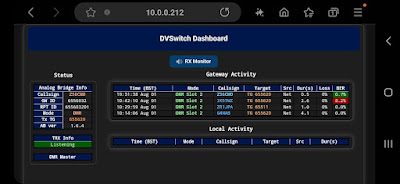Foto: Ystervarkpunt-vuurtoring
"Vuurtorings het vir baie jare 'n belangrike rol in maritieme navigasie gespeel en skepe veilig langs ons verraderlike kuslyn gelei. Hierdie argitektoniese wonders simboliseer die belangrikheid van kommunikasie."
TUINROETE | KAROO NUUS - Suid-Afrika se Amateurradio Vuurtoringnaweek het radioamateurs van regoor die land van 17 tot 18 Augustus bymekaar gebring om hul passie vir kommunikasie en tegnologie te deel.
Sewe amateurs van die Eden-radioklub het Vrydagoggend by Ystervarkpunt-vuurtoring byeengekom en antennas opgeslaan.
Die Ystervarkpuntvuurtoring is in Gourikwa-natuurreservaat, halfpad tussen die kusdorpe, Gouritsmond en Stilbaai.
Die mans het hoog vanaf die ligtoring 'n antenna gespan wat een van die lede, Willie Hewitt (ZS2CC) gemaak het en dit tot heel onder vertikaal laat hang.
Corné Conradie (ZS1COR) van Eden-radioklub, sê hierdie jaarlikse naweek bied 'n platform vir radioamateurentoesiaste om hul vaardighede ten toon te stel, kennis uit te ruil, die publiek geïnteresseerd te kry en om aan 'n vriendskaplike kompetisie deel te neem waar kameraderie opnuut versterk word.
Dit alles, terwyl hulle omring word deur die boeiende skoonheid en betekenis van Suid-Afrika se vuurtorings.
Vuurtorings inspireer
"Vuurtorings het vir baie jare 'n belangrike rol in maritieme navigasie gespeel en skepe veilig langs ons verraderlike kuslyn gelei. Hierdie argitektoniese wonders simboliseer die belangrikheid van kommunikasie. In die moderne era is langafstandradiokommunikasie 'n onmisbare aspek tydens navigasie, maar tog speel vuurtorings steeds 'n belangrike rol," vertel Conradie.
Met vuurtorings as inspirasie, is die vuurtoringnaweek geskep om jaarliks die gees van konnektiwiteit onder radioamateurs in Suid-Afrika en wêreldwyd te vier. Deelnemers demonstreer dan hul tegniese vaardighede met die vinnige opstel van moderne radiostasies met verskillende antennas en deel hul passie vir radiokommunikasie.
Deelnemers van verskillende klubs kom in spanne by verskeie ligtorings langs die kus bymekaar wat dan as fokuspunt vir hul aktiwiteite dien.
Gedurende die naweek het radioamateurs hul kommunikasiestelsels opgestel om soveel as moontlik kontak te maak met mede-entoesiaste - plaaslik en regoor die wêreld.
Ons het dit gedoen!
Conradie sê die Eden-radioklub het met 'n Kenwood ts2000 vanuit die vuurtoringhuisie gepraat. "Ons het 80 kontakte gemaak en met 10 vuurtorings in Suid-Afrika en een stasie in Duitsland gepraat. Kondisies was baie goed en ons het sommer al Saterdagoggend net na 06:30 ons eerste kontak gemaak."
Hy sê een van die "Ons het dit gedoen!"-oomblikke was waar die vuurtoringoperateurs opeenhopings (pile-ups) moes hanteer waar verskeie roepe gelyktydig inkom. "Vir die operateurs wat roep na die vuurtorings en wat se sein gehoor word bo ander, is dit 'n veer in die hoed," sê Conradie.
Hy sê die naweek kweek 'n gevoel van kameraadskap onder die deelnemers aangesien hulle streef om met soveel as moontlik stasies kontak te maak met hul tydelike stasie - kontakte gemaak deur die vuurtoringoperateurs, sowel as kontakte gemaak na vuurtorings deur individuele operateurs.
Boeiende stokperdjie
"Die vuurtoringnaweek speel 'n belangrike rol in die bevordering van amateurradio as 'n stokperdjie. Deur die vermoëns en kameraadskap van entoesiaste ten toon te stel, lok die geleentheid gesoute amateurs, nuwe amateurs en mense wat nuuskierig is oor die stokperdjie. Dit is weereens hierdie naweek bewys deur die letterlik duisende kontakte wat gemaak en gelog is."
Conradie hoop dat die blootstelling wat tydens die naweek gegenereer word, help om bewustheid te verhoog oor die voordele van radioamateurkommunikasie. "Hopelik sal dit weer nuwe entoesiaste inspireer om by ons gemeenskap aan te sluit en om die kulturele, argitektoniese en erfeniswaarde van ons vuurtorings te waardeer."
Daar is darem nie net per radio gekommunikeer nie en tussendeur het die vure gebrand en het die deelnemers lekker saamgekuier.
Vir nog foto's en inligting besoek Eden Radio Club op Facebook, Instragram en YouTube.
Kontak Eden-radioklub by edenradioclub@gmail.com.
Fotos (Klik op fotos om te vergroot)
Foto: Eden-radioklub het met 'n Kenwood TS2000 vanuit die vuurtoringhuisie gepraat.
Foto: Willie Hewitt ZS2CC
Foto: Danie Leonard ZS1DL
Foto: Henry Hansen ZS1SB
Foto: Eben Hewitt ZS1HEB
Foto: Corné Conradie ZS1COR
Foto: Ystervarkpunt-vuurtoring is in Rein's-natuurreservaat, halfpad tussen Gouritsmond en Stilbaai. - B van Zyl

























